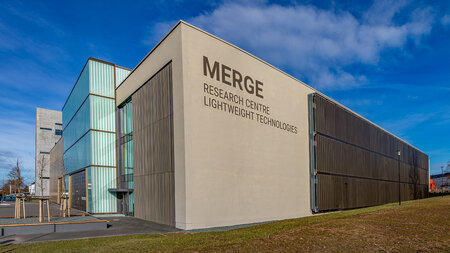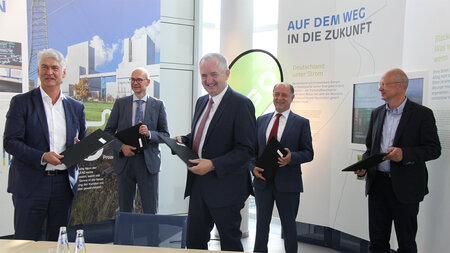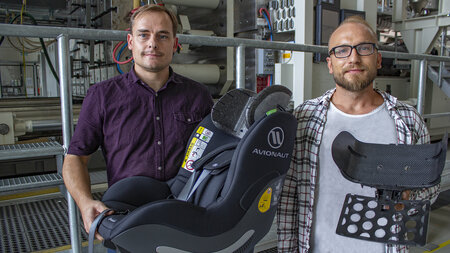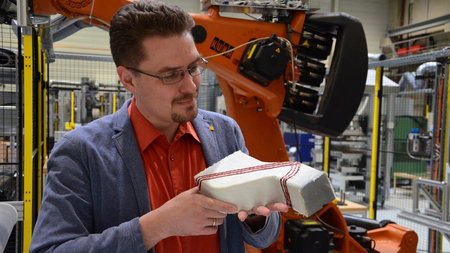Core Competency "Resource-Efficient Production and Lightweight Structures"
Resource and energy efficiency are the key to an ecologically and commercially sustainable economy. They can be used to effectively meet the growing global demand for energy, increased mobility, as well as the emission of climate-damaging greenhouse gases and the resulting climate change. Resource-efficient production processes and the use of lightweight structures offer great potential for this. The vision of tapping existing savings potentials both in production and during the utilisation phase, the so-called Bivalent Resource Efficiency (BRE) strategy, is being pursued here. The optimisation of manufacturing processes, Industry 4.0, merging of established basic technologies, integration of intelligent systems, use of renewable energies and recycling management are the particular focus of the research work.
Energy-autonomous, virtually emission-free production with a simultaneous reduction in energy requirements and an increase in resource efficiency can be achieved, for example, by optimising efficiencies in production and developing energy management systems. Industry 4.0 in this context means the networking of autonomous, situationally self-controlling, self-configuring, knowledge-based, sensor-supported, and spatially distributed production resources (production machines, robots, conveyor and storage systems, operating equipment), including their planning and control systems. Lightweight construction is one of the game-changing industries of the 21st century and is also becoming increasingly important due to the growing electrification of mobility. The lower weight of transport vehicles can significantly increase ranges. The merging of currently separate manufacturing steps in the processing of different material groups such as textiles, plastics, and metals offers particular savings advantages in the production of lightweight structures. At the same time, smart systems such as sensors and actuators can be integrated.
The individual competencies and potentials of different research areas available at Chemnitz University of Technology are combined and bundled across faculties and topics. The integration of basic research and the transfer of knowledge to derive innovative products and processes contribute to the structural development of Chemnitz as a scientific location and to the economic strengthening of the regional industry.
News
-
Forschung
 High-Tech for Saxon Lightweight Construction Research
High-Tech for Saxon Lightweight Construction Research Lightweight Technologies laboratory building at the MERGE Research Centre at Chemnitz University of Technology completed - Free State of Saxony invested around 14.5 million euros, most of which came from the European Regional Development Fund (ERDF)
-
Forschung
 Research into “green” carbon fibres to contribute to coal phase-out
Research into “green” carbon fibres to contribute to coal phase-outThe Free State of Saxony, Lausitz Energie Kraftwerke AG, the Fraunhofer Institute for Machine Tools and Forming Technology (IWU), the Fraunhofer Institute for Applied Polymer Research (IAP) and the Cluster of Excellence MERGE of Chemnitz University of Technology have signed a letter of intent on the InnoCarbEnergy project at the Boxberg power plant site
-
Forschung
 Lighter headrest for child car seats thanks to German-Polish research cooperation
Lighter headrest for child car seats thanks to German-Polish research cooperation Researchers at Chemnitz University of Technology, together with companies in Thuringia and Poland, have developed a 26 percent lighter headrest for a child seat and established the technical foundations for its resource-efficient production
-
Forschung
 The perfect thread guide
The perfect thread guideResearchers at Chemnitz University of Technology, in cooperation with Pfeil GmbH, are developing a new type of blind stitch sewing technology for the production of high-performance lightweight components
Key Research Areas in the Core Competency "Resource-Efficient Production and Lightweight Structures"
Efficient lightweight construction solutions use the synergetic combination of different materials. In many areas, textile, plastics, and metal processing are still separated from each other, making individual steps and complex joining technologies necessary. Therefore, research at Chemnitz University of Technology aims to merge basic technologies suitable for large-scale production for the resource-efficient manufacture of lightweight structures with high performance and functional density.
In addition to technology fusion, active components such as sensors, actuators, and generators are integrated as electronic modules by in-line or in-situ processes to achieve the next level of highly functional lightweight structures. The aim here is to integrate this step directly into the manufacturing process. Components equipped with sensors or actuators already help to detect wear and tear at an early stage, for example in wind turbines, and facilitate maintenance, which is often very costly.
In this context, Industry 4.0 is understood as the networking of autonomous, situationally self-controlling, self-configuring, knowledge-based, sensor-based, and spatially distributed production resources (production machines, robots, conveyor and storage systems, operating equipment), including their planning and control systems.
Innovative solutions consisting of different components require a responsible use of resources. The focus here is not only on the economical use of raw materials in the manufacture of a product, the resource efficiency during the use of a product is also decisive for reducing CO2 emissions. Furthermore, strategies for the use of renewable raw materials as well as the recyclability of multi-material systems are central points of the research work at Chemnitz University of Technology.
Contact
Speaker of the working group "Resource-Efficient Production and Lightweight Structures":
- Prof. Dr. Lothar Kroll
Phone: +49 371 531-35706
Email: lothar.kroll@…
Deputy speakers:
- Prof. Dr. Klaus Stöwe
Phone: +49 371 531-35241
Email: klaus.stoewe@… - Prof. Dr. Jan-Frederik Pietschmann
Phone: +49 371 531-36901
Email: jfpietschmann@…
Projects (Selection)
CRC/TRR 96 "Thermo-energetic design of machine tools"
Funding Agency: DFG
Funding Period: 2011-2023
website
FOR 5380 "Functional surfaces through adiabatic high-speed processes: Microstructure, mechanisms and model development (FUNDAM³ENT)"
Funding Agency: DFG
Funding Period: since 2022
website (de)
"Advanced Materials and manufacturing technologies United for LightwEighT (AMULET)"
Funding Agency: EU/HORIZON2020
Funding Period: 2021-2024
website
"Research platform Refrigeration and Energy Technology (KETEC)"
Funding Agency: BMBF/7. Energieforschungsprogramm
Funding Period: 2021-2025
website (de)
"AI-supported, partially automated dismantling of traction batteries (KaDoTE)"
Funding Agency: BMWK
Funding Period: 2023-2025
"Carbon, Systems and Mobility Solutions Saxony at power plant location Boxberg/Upper Lusatia (InnoCarbEnergy)"
Funding Agency: BMWK
Funding Period: 2022-2026
EXC 1075 "Merge Technologies for Multifunctional Lightweight Structures (MERGE)"
Funding Agency: DFG
Funding Period: 2012-2019
website
CRC/TRR 39 "Production Technologies for light metal and fiber reinforced composite based components with integrated Piezoceramic Sensors and Actuators (PT-PIESA)"
Funding Agency: DFG
Funding Period: 2006-2018
website
CRC 692 "High-strength aluminium-based lightweight materials for safety components (HALS)"
Funding Agency: DFG
Funding Period: 2006-2017
website
FOR 1497 "Twin-Polymerisation of Organic-Inorganic Hybrid Monomers to Nanocomposites"
Funding Agency: DFG
Funding Period: 2011-2019
website
"Digital technologies for hybrid lightweight structures (DAHLIA)"
Funding Agency: EU/Free State of Saxony/EFRE/ESF
Funding Period: 2020-2022
website (de)
ESF Young Researchers Group "Automated, component contour-near production of bio-based lightweight sandwich structures (ecoWing)"
Funding Agency: EU/Freistaat Sachsen
Funding Period: 2020-2022
website (de)
ESF Young Researchers Group "High entropy alloys as coating materials for surface protection applications (HEA-SurfProtect)"
Funding Agency: EU/Free State of Saxony
Funding Period: 2020-2022
website (de)
ESF Young Researchers Group "New materials for fuel cells (NeMaCell)"
Funding Agency: EU/Free State of Saxony
Funding Period: 2020-2022
website (de)
"Saxon alliance for material- and resource-efficient technologies (AMARETO)"
Funding Agency: EU/Free State of Saxony/EFRE
Funding Period: 2017-2020
website
"Near-series technologies for highly stressed hybrid multilayer crash structures (hybCrash)"
Funding Agency: EU/Free State of Saxony/EFRE/ESF
Funding Period: 2016-2020
website (de)
Cutting-edge technology cluster of the Saxon State Excellence Initiative "Energy-efficient product and process innovations in production engineering (eniPROD)"
Funding Agency: EU/Free State of Saxony
Funding Period: 2009-2015
website
"Collaborative digital twin in value creation networks (Co-TWIN)"
Funding Agency: BMBF
Funding Period: 2019-2022
website (de)

